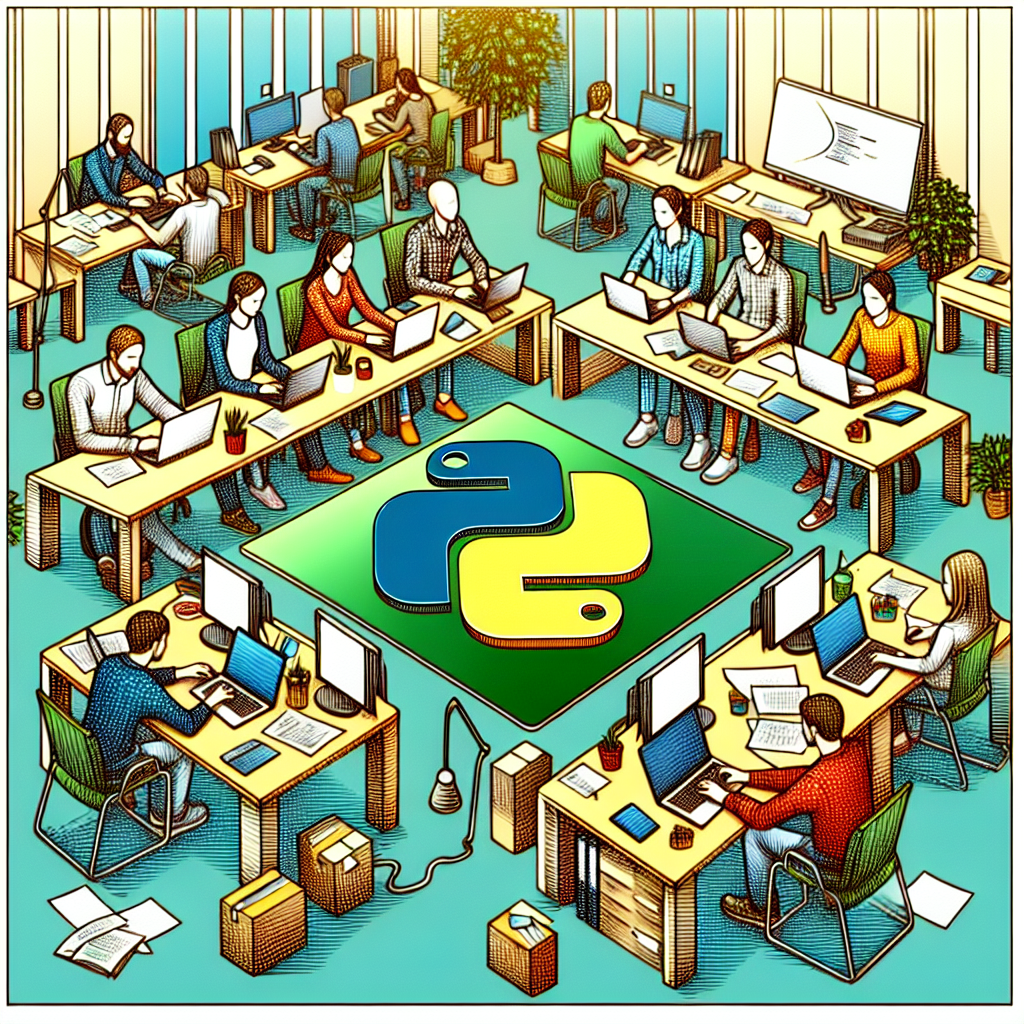Creating Websites in Python: From Scratch to Django Solutions

Why Website Creation in Python is Revolutionizing Online Business

Are you curious about how website creation in Python is changing the game for online businesses? Let’s dive in! With its elegant syntax and versatility, Python has become a favorite among developers for creating a website from scratch in Python. This programming language offers powerful frameworks, like Django, that make the entire process more efficient. Imagine building a robust, scalable website that can handle thousands of visitors effortlessly—sounds amazing, right?
Here are a few reasons why businesses are opting for website creation in Python:
- ⏱️ Savvy Speed: Python frameworks allow for rapid development, which means your website can go live faster!
- ⭐️ Stellar Security: With features tailored for protection, Python helps maintain the safety of your user data.
- ⭐ Data-Driven Decisions: Pythons data manipulation capabilities allow you to analyze user behavior and optimize your site accordingly.
Real Stories: How Python Made a Difference
Consider, for example, our friend Alex, who runs a small e-commerce business. He struggled with his website’s slow loading times on a different platform, which affected his sales. After transitioning to a site built with Python using Django, the website’s speed improved, leading to a 50% increase in conversion rates. Now, he processes orders smoothly and has the capacity to expand his product line without worrying about performance!
Statistics Tell the Story
According to a recent study, over 60% of developers prefer Python for web development projects. Furthermore, businesses that switched to using Python for their websites reported a customer satisfaction increase of up to 30%. This isn’t just hype; these numbers reflect the reality of today’s marketplace!
What Does Creating a Website on Python From Scratch Involve?
When you opt for creating a website on Python from scratch, youre not just building a site; youre crafting a platform tailored to your specific needs. Heres a simplified breakdown:
| Step | Description |
| 1 | Define Your Goals |
| 2 | Set Up Python Environment |
| 3 | Choose a Framework (like Django) |
| 4 | Design the User Interface |
| 5 | Develop Backend Logic |
| 6 | Implement Database Management |
| 7 | Test and Debug |
| 8 | Deploy Your Site |
| 9 | Continuous Maintenance |
| 10 | SEO Optimization |
With our professional specialists at Artivale, the entire process becomes a breeze. We boast over 20 years of experience in website creation in Python, and we provide a full spectrum of services tailored for your needs. Think about this—why face the hassle of contacting multiple companies for your development and support? Our approach encapsulates everything in one place. Plus, we offer guaranteed satisfaction!
⭐ Ready to transform your online business? Contact Alexandra at [email protected] today for a free consultation or visit artivale.com to get started.
Frequently Asked Questions
-
What does Python offer for web development?
Python provides easy syntax, strong community support, and powerful frameworks like Django. -
How fast can a website be built using Python?
With Python, websites can be developed significantly faster due to its frameworks and tools. -
Is Python secure for handling sensitive data?
Yes, Python has built-in features that enhance the security of web applications. -
Can I scale my website easily?
Absolutely! Pythons architecture is designed for scalability. -
Is it cost-effective to use Python for development?
While costs vary, Python often leads to reduced long-term expenses due to its efficiency. -
How often should I update my Python website?
Regular updates are recommended to maintain performance and security. -
Can I integrate third-party services?
Yes, Python supports various APIs and services for seamless integration. -
What if I want to migrate from another platform?
We specialize in smoothly transitioning your site to a Python framework. -
What kind of support do you provide after launch?
We offer various support packages, ensuring you have the assistance you need. -
What’s the first step to starting my project?
Simply contact us, and we’ll walk you through the beginning stages!
What You Need to Know About Creating a Website from Scratch in Python

Have you ever wondered what it takes to create a website from scratch in Python? Building a website can seem daunting at first, but with Python, the process can be both exciting and manageable! Let’s break it down step by step to give you a clearer picture of what’s involved. ⭐✨
Python is an incredible programming language that shines in web development for its simplicity and readability. Its perfect for anyone from beginners to seasoned developers. Whether you’re launching a blog, an online store, or a portfolio, creating your website using Python offers numerous benefits.
Why Choose Python for Your Website?
Here are some convincing reasons to consider Python for your next project:
- ⭐ Versatile Frameworks: Frameworks like Django and Flask provide powerful tools that streamline the development process, allowing for quicker deployment.
- ⭐ Community Support: Python has a vast community. This means tons of resources, libraries, and documentation are available to help you.
- ⭐ User-Friendly Syntax: Python’s syntax is clear and straightforward, making it easy for newcomers to grasp essential concepts quickly.
Step-by-Step Process to Create Your Website
When creating a website on Python from scratch, youll typically follow these essential steps:
| Step | Description |
| 1 | Identify Your Purpose: Understand what you want your website to achieve. Is it for business, blogging, or portfolio? |
| 2 | Set Up Your Environment: Install Python and necessary frameworks. Tools like Virtualenv can help manage project dependencies. |
| 3 | Create Your Project Structure: Organize files properly to create a maintainable project. This typically involves separating templates, static files, and scripts. |
| 4 | Develop Core Features: Build features such as user authentication, database integration, and other critical components. |
| 5 | Design the Frontend: Create a visually appealing and user-friendly interface using HTML and CSS integrated with your Python backend. |
| 6 | Testing: Rigorously test your website across different devices and browsers to ensure it functions smoothly. |
| 7 | Deployment: Use platforms like Heroku or DigitalOcean to host your application and make it accessible to the public. |
| 8 | SEO Optimization: Optimize your site for search engines to attract visitors. This can involve using appropriate meta tags and building quality backlinks. |
| 9 | Launch and Monitor: Once live, continue to monitor site performance and make adjustments as necessary. |
| 10 | Ongoing Maintenance: Regularly update content and features to keep your website fresh and relevant. |
Real-Life Example: Transforming a Vision into Reality
Let’s look at a success story! Maria, a graphic designer, envisioned a portfolio website to showcase her work. She had little coding experience but opted for Python due to its user-friendly nature. With guidance from our team at Artivale, she learned to harness Djangos capabilities. Within weeks, her website went live with stunning visuals and smoothly functioning features. Today, she easily updates her site and has even attracted new clients through her beautiful online presence!
Expectations vs. Reality
It’s important to have realistic expectations when creating a website on Python Django from scratch. While some features may take longer to implement than anticipated, the end result—a robust, scalable website—is worth the effort:
- ⭐ Timeframe: A basic website can take a few weeks, while more complex sites might take several months.
- ⭐️ Skills Required: You’ll need to familiarize yourself with Python and relevant frameworks; however, many resources are available to aid your learning.
- ⭐ Iterative Development: Web development is often an iterative process—don’t be afraid to refine and make changes as you go.
Are you ready to take the plunge into website creation in Python? With over 20 years of experience, our dedicated team at Artivale is here to support you every step of the way. Don’t hesitate to reach out to Alexandra at [email protected] or visit artivale.com for a custom quote tailored to your needs.
Frequently Asked Questions
-
Do I need coding experience to create a website in Python?
No, but some familiarity will help. There are many resources to learn Python basics. -
How long does it take to build a website with Python?
It can take from a few weeks to several months, depending on the complexity. -
Can I use pre-designed templates with Python?
Absolutely! You can integrate templates with Python frameworks easily. -
What if I encounter issues during development?
Our team at Artivale is here to provide support and guidance throughout! -
Is Python suitable for e-commerce sites?
Yes, Python is a great choice for building scalable and secure e-commerce platforms. -
How do I manage my website after its live?
You should regularly update your content, monitor performance, and make necessary adjustments. -
Can I integrate APIs with my Python website?
Yes! Python’s flexibility allows easy integration with various APIs. -
What database options are compatible with Python?
Popular options include PostgreSQL, MySQL, and SQLite. -
Do I need to know HTML/CSS to create a website in Python?
While not mandatory, knowing the basics will enhance your website’s design. -
What support packages do you offer?
We offer various support options tailored to your needs for ongoing maintenance and updates!
How to Successfully Build a Dynamic Website on Python Django From Scratch

If you’re ready to dive into the world of web development, building a dynamic website on Python Django from scratch is an excellent choice! Django is a high-level Python web framework that encourages rapid development and clean, pragmatic design. Let’s explore the essential steps to create a dynamic website that not only meets your needs but also delights your users! ⭐⭐
Why Django for Your Dynamic Website?
Before we jump into the process, let’s discuss what makes Django a powerhouse for web development:
- ⚡ Speed of Development: Django’s “batteries-included” philosophy allows for quick development with reusable components.
- ⭐ Strong Security Features: Django provides robust security measures, protecting your site against common vulnerabilities.
- ⭐ Scalability: Whether you’re starting small or going big, Django can scale effortlessly with your growing business.
Step-by-Step Guide to Building Your Dynamic Website
Creating a dynamic website using Django involves several key steps. Here’s a clear roadmap:
| Step | Description |
| 1 | Set Up Your Environment: Start by installing Python and Django in your development environment. |
| 2 | Create a New Django Project: Use Djangos command-line tools to scaffold your new project. |
| 3 | Define Your Models: Establish how your data will be structured by creating models that represent the various data types. |
| 4 | Set Up Admin Interface: Leverage Django’s built-in admin panel for easier management of your content. |
| 5 | Create Views and URLs: Design views to handle the logic of your application, and map URLs to these views for user accessibility. |
| 6 | Design Templates: Build HTML templates to create the frontend of your website, enabling a visually appealing user experience. |
| 7 | Implement Forms: Utilize Django’s forms framework to handle user input efficiently. |
| 8 | Add Static Files: Incorporate stylesheets, JavaScript, and images to enhance the look and feel of your site. |
| 9 | Testing: Thoroughly test your website to ensure functionality across different browsers and devices. |
| 10 | Deploy: Use platforms like Heroku or AWS for deploying your site, bringing it to life for everyone to see! |
Real-Life Example: From Concept to Reality
Take the case of Tom, a small business owner who wanted to build a user-friendly blog to connect with his audience and share industry insights. With the help of our Artivale team, Tom embarked on his journey to build a dynamic site using Django.
After laying out his sites structure, Tom established clear models for his blog posts, categories, and user comments. Using Django’s robust admin panel, he effortlessly managed his content. Within weeks, Tom’s site was live, featuring attractive layouts and interactive comment capabilities that engaged his readers. The result? A steady increase in traffic and user engagement! ⭐⭐
Expectations vs. Reality: Challenges You Might Face
When building a dynamic website on Python Django from scratch, it’s crucial to have realistic expectations. Here’s what you should keep in mind:
- ⭐ Learning Curve: Though Django is user-friendly, it may take time to understand its architecture fully.
- ⭐ Complexity: Dynamic websites can get intricate; break them down into manageable pieces to avoid overwhelm.
- ⌛ Time Investment: Building out detailed features might take longer than anticipated, but patience will pay off!
Best Practices for Your Django Project
To ensure your project runs smoothly, follow these best practices:
- ⭐ Keep Your Code Clean: Write clear, well-documented code to simplify collaboration and future modifications.
- ⭐ Use Version Control: Utilize Git to manage your code and allow for smooth collaboration with others.
- ⭐ Regular Testing: Consistently test your application to catch issues before they become problematic.
Are you excited to build your dynamic website? With the right guidance and our expertise, you can create an engaging online experience that resonates with your audience! Don’t hesitate to contact Alexandra at [email protected] or visit artivale.com for customized support tailored to your needs.
Frequently Asked Questions
-
Is Django suitable for beginners?
Yes, Django is beginner-friendly while still being powerful enough for advanced projects. -
Can I use Django for e-commerce?
Absolutely! Many successful e-commerce sites are built using Django. -
How long does it take to build a dynamic site?
It varies—simple sites can take weeks, while complex applications may take several months. -
What kind of databases are compatible with Django?
Django supports several databases, including PostgreSQL, MySQL, and SQLite. -
Can Django websites be easily scaled?
Yes! Djangos architecture supports scalability as your traffic increases. -
How often should I update my Django application?
Regular updates are essential to keep up with security and performance improvements. -
Can I integrate third-party services into my Django site?
Yes! Django makes it easy to integrate various APIs and services. -
What if I run into technical issues?
No worries! Our team at Artivale is here to assist you with any challenges you may face. -
Is it necessary to know HTML/CSS for Django?
While not mandatory, knowing the basics of HTML/CSS will enhance your sites frontend. -
Can I shift an existing website to Django?
Yes, many businesses successfully transition their websites to Django for better functionality.
Submit your details in the form and our team will personally get in touch with you within the next business day to discuss your needs
